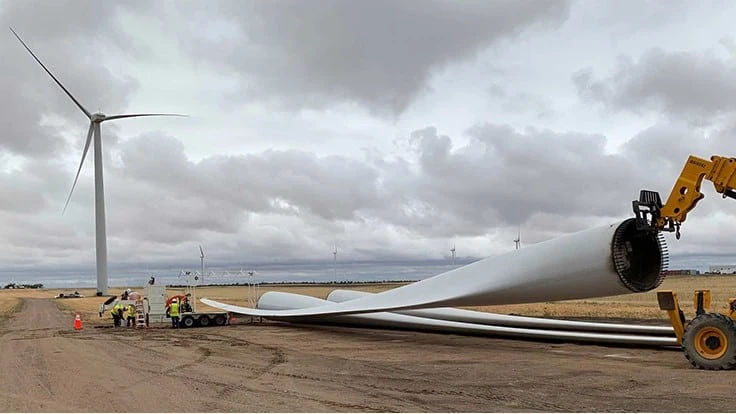
Photo provided by Veolia North America
Boston-based Veolia North America (VNA) says it has signed a multiyear agreement with Schenectady, New York-GE Renewable Energy to collect blades removed from GE’s onshore turbines and process them for consumption in cement kilns. The blades are made of fiberglass blended with other materials.
VNA says it has a successful history of supplying repurposed engineered materials to the cement industry, and that similar recycling processes in Europe, where VNA’s parent company is based, have proven effective at a commercial scale.
As part of the agreement, blades that have been removed from turbines will be shredded at a VNA processing facility in Missouri and then used as a replacement for coal, sand and clay at cement manufacturing facilities in the United States.
On average, nearly 90 percent of the blade material, by weight, will be reused as a repurposed engineered material for cement production, says VNA. More than 65 percent of the blade weight replaces raw materials that would otherwise be added to the kiln to create the cement, and about 28 percent of the blade weight provides energy for the chemical reaction that takes place in the kiln.
“Sustainable disposal of composites such as wind turbine blades has been a challenge, not only for the wind turbine industry but also for aerospace, maritime, automotive and construction industries,” says Anne McEntee, CEO of GE Renewable Energy’s Digital Services business. “VNA’s unique offering provides the opportunity to scale up and deploy quickly in North America, with minimum disruption to customers and significant benefit to the environment.”
Wind turbine blades are sometimes replaced through turbine improvement or “repowering” efforts, when some components of the turbine are upgraded to improve the efficiency and life span of the turbine, without replacing the entire unit.
“By adding wind turbine blades — which are primarily made of fiberglass — to replace raw materials for cement manufacturing, we are reducing the amount of coal, sand and minerals that are needed to produce the cement, ultimately resulting in greener cement that can be used for a variety of products,” remarks Bob Cappadona, chief operating officer of VNA’s Environmental Solutions and Services division. “Last summer we completed a trial using a GE blade, and we were very happy with the results. This fall we have processed more than 100 blades so far, and our customers have been very pleased with the product.”
VNA employs 20 people at the Missouri processing facility, which is located about 70 miles northwest of St. Louis.
An environmental impact analysis conducted by the U.S. office of Switzerland-based Quantis U.S. found that compared to traditional cement manufacturing, blade recycling enables a 27 percent net reduction in CO2 emissions from cement production and 13 percent net reduced water consumption. In addition, a 7-ton blade recycled through the process enables the cement kiln to avoid consuming nearly five tons of coal, 2.7 tons of silica, 1.9 tons of limestone and nearly 1 ton of additional mineral-based raw materials.
Latest from Recycling Today
- BMW Group, Encory launch 'direct recycling’ of batteries
- Loom Carbon, RTI International partner to scale textile recycling technology
- Goodwill Industries of West Michigan, American Glass Mosaics partner to divert glass from landfill
- CARI forms federal advocacy partnership
- Monthly packaging papers shipments down in November
- STEEL Act aims to enhance trade enforcement to prevent dumping of steel in the US
- San Francisco schools introduce compostable lunch trays
- Aduro graduates from Shell GameChanger program





